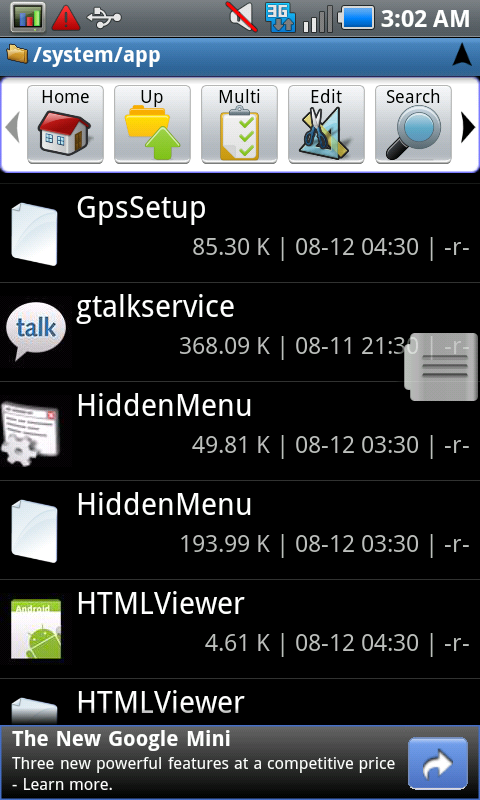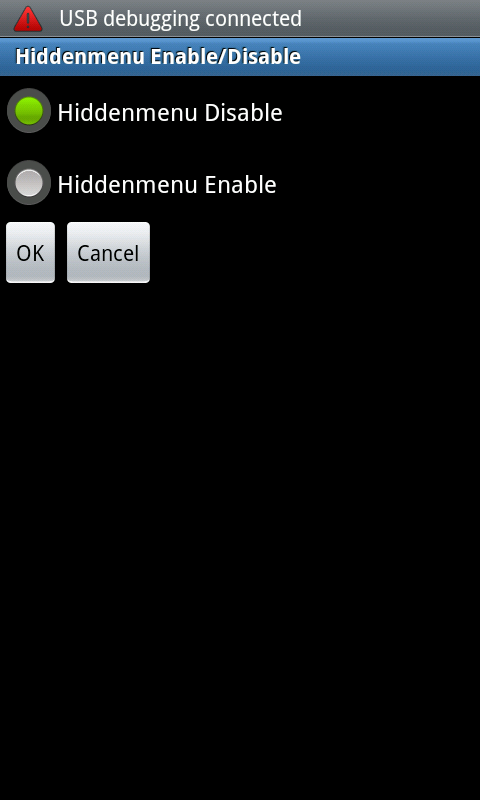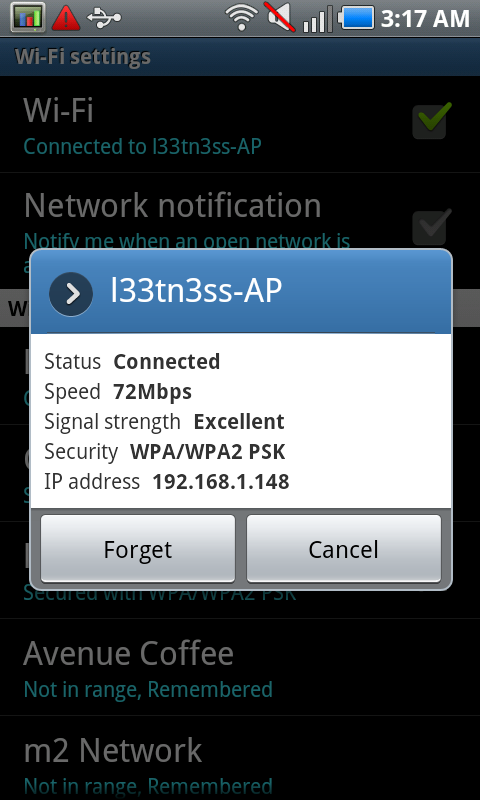Samsung Fascinate Review: Verizon's Galaxy S Smartphone
by Brian Klug on October 5, 2010 12:01 AM EST- Posted in
- Smartphones
- Samsung
- Galaxy S
- Fascinate
- Mobile
Cellular and WiFI Performance
The Fascinate doesn't have any antenna problems or weird baseband quirks. I experienced stable data connections and calls. We still run the phone through our now-regular tests to determine attenuation from holding devices in different positions.
| Signal Attenuation Comparison in dB—Lower is Better | |||||||
| Cupping Tightly | Holding Naturally | On an Open Palm | |||||
| Samsung Fascinate | 10.0 | 5.0 | 0.0 | ||||
| Droid 2 | 11.5 | 5.1 | 4.5 | ||||
| BlackBerry Torch | 15.9 | 7.1 | 3.7 | ||||
| Dell Streak | 14.0 | 8.7 | 4.0 | ||||
| Droid X | 15.0 | 5.1 | 4.5 | ||||
| iPhone 4 | 24.6 | 19.8 | 9.2 | ||||
| iPhone 3GS | 14.3 | 1.9 | 0.2 | ||||
| HTC Nexus One | 17.7 | 10.7 | 6.7 | ||||
The Fascinate (like the Epic 4G) seems to only expose signal changes in 5 dBm steps. Like Anand in the Epic review, I measure exactly the same thing. It's a bit frustrating to measure, but I managed to do so on the Fascinate after taking a lot of data - it didn't change. Unsurprisingly, attenuation is completely in line with what we've seen for other typical smartphones, sans iPhone 4. It's a bit frustrating that the radio stack doesn't show more granularity like other Android devices I've played with (all of them to date have showed me signal in 1 dBm steps), so I was determined to find more.
Just about every phone has special dialer codes. They're usually prefixed with "##" or asterisks, and just about every Android device has the somewhat famous "*#*#4636#*#*" special menu for doing basic things. The Captivate and Vibrant have gotten quite a bit of attention for having extremely thorough secret dialer codes, something I seriously favor in any device.
Regardless, I set out to discover whether any internal dialer codes could reveal more hardware information than I was seeing in Android through the UI and normal APIs.
To do so, I searched through the .apk files inside /system/app. Android package files are essentially zip files with a number of other files for the Android platform inside, including AndroidManifest.xml. Unfortunately, that XML file is encoded in binary, and requires some special unpacking. Regardless, I searched through and found lots of tasty goodness inside the ever so auspiciously-named hiddenmenu.apk file.

I found what I think are the Fascinate's internal codes, but none of the dialer prefixes I can think of work. Searching through everything in the Samsung GPL code repository for SCH-i500 (the Fascinate's model name) thoroughly revealed nothing either. The Samsung GPL code repository is here, just search SCH-i500 and you'll get the whole thing. It's possible that I missed the dialer code prefixes in there, but at the end of the day I couldn't find them. I also manually tried everything I could think of.
If you're so inclined, that AndroidManifest.xml file is up on pastebin here. There's a few interesting things inside. At the end of the day, however, I couldn't make anything work.
Update:
With the help of a friend with access to more information than I ;), I was able to finally figure out how to enable secret codes on the Fascinate. It's one of the most complicated procedures I've seen on a phone to date, but not impossible:
In the dialer, enter *#83786633 and tap the home button. Now, go back into the dialer, clear anything still in the dialer completely (the first code should still be there), and enter *#22745927. You'll be prompted for an SPC code, which should be 000000. Now you should get dumped to a screen like this:

Toggle enable, hit ok, and then things should work. This is the hiddenmenuenable apk I spent forever trying to get to. The dialing prefix is then *# with a suffix of # which is just like the other Galaxy S phones I've seen. Even then, the dialer codes are somewhat obfuscated - the only one I've found so far is #*4636*1111# which brings up the testing menu standard to other Android devices. I'm sure there are more out there.

Finally, I ran well over 100 speedtests on the Fascinate using the SpeedTest.net application, and averaged a downstream speed of 0.888 megabits/s, and upstream speed of 0.673 megabits/s. That's roughly in line with performance around town, with spikes up to 1.8 megabits/s of downstream near a tower.
WiFi Performance
The Fascinate negotiates a 72 megabit/s link with my 802.11N network - faster than the 65 megabits/s I've seen which is the bare minimum required to meet 802.11N requirements.

Wireless range on the Fascinate isn't quite as far as the EVO 4G or iPhone 4. I can make it a few more meters to the curb before falling off my AP on other devices. That said, the WiFi performance itself is not bad - 20 megabits/s on my 802.11n network downloading a 100 MB PDF.

There's also tethering support on the Fascinate, however the device I had time with wasn't provisioned for access and I couldn't test it. I could however get to the provisioning portal Verizon has, and that worked fine, but I couldn't tell if there were any hotspot issues like the Droid 2 had.










73 Comments
View All Comments
chemist1 - Tuesday, October 5, 2010 - link
kmmantey: Thanks for your comment. I agree audio quality does change with various factors. However, I would say that does not preclude it being of importance, nor being rateable. [ As softdrinkviking said below, one can do an "all things being equal" test.] Yes, various factors can degrade audio; but if you start with really good audio performance then, as you lose quality, at least you're losing from a higher starting point.I think saying "no one cares that much about call quality" is too strong. Granted, most may not care as much as me :). But, even in a mainstream publication like Consumer Reports, voice quality is listed as third among the 11 criteria they use in ranking smart phones (and I think CR has a pretty good bead on what its readership cares about).
More importantly, what should be important here is not what most care about, but rather what we, as presumably more informed and discriminating consumers ;), would find desirable. And I believe that many of us —perhaps even you!—would find a phone that provides significantly better audio quality more pleasing to use.
awaken688 - Wednesday, October 6, 2010 - link
I have to disagree Kmmatney. In fact, in the Droid 2 article I made a similar comment to Brian. For those of us with poor experiences with phones (using the phone part), making sure we get a strong quality phone for phone calls is very important. I want to know that in my car driving on the highway, I can hear someone clearly (is the volume level adequate). That if I am forced to turn it up to the highest volume, it doesn't have distortion. Things of that nature. I know Brian said he is working on it, so I will wait.Brian,
In the meantime, I'd still even appreciate a slightly unscientific test. Take the phone in your car on the same highway at a set speed. Call a recording (make sure it on par with an average human conversation, maybe even quieter to simulate a quiet speaker). Call a friend who can play a recording from a PC at a set volume/distance from a constant phone to simulate those loud and quiet talkers. I'm sure you will think of something. As long as you state it is a placeholder and unscientific, most of the people will completely understand. I'm sure you will have those 1 or 2 idiots post a comment complaining, but don't worry about them. There are many more of us who comment rarely and read daily.
MGSsancho - Tuesday, October 5, 2010 - link
set up your own cell site and connect to that? then make your own phone server with asterick and connect to that? thats a massive about of work dude or see if anyone have mad an app that can poll the codec info using the api? this guy made hos own cell site for 2G but might work on 3G http://www.tombom.co.uk/blog/ if you said you have played with cdma codecs then ill assume you know how to use asterisk lolthere are various ways but i think can think might be better. use a really good mic and take a recording from the sidewalk where you take video from and from other busy/common places, then use those audio files for testing. setup an audio chamber with a speaker playing those recordings. then use a directional mic really close to the speaker of the phone and do analysis on that. make the whole box out of foam so wireless signal doesn't get distorted. you can later intentionally weaker the wireless signal and record how the voice quality drops if you like. This way we can see what the phone sounds like at a club, classroom, sidewalk, store, high winds etc. too shorten this up, get controlled recordings, set up phones in a controlled box then use signal analysis on what comes out of the phones line-out/speaker.
Good Luck
Samoht - Tuesday, October 5, 2010 - link
This is really starting to worry me. Why do these carriers keep messing up good phones?I know that they are trying to differentiate themselves but crippling a product like this is not good business.
And this is on top of the skins from Samsung/HTC/SonyEricsson.
I really hope Google will realise that they need to raise the bar again and make a vanilla phone with gingerbread (tasty :-).
xype - Tuesday, October 5, 2010 - link
"Wait another 6 - 8 months, and you'll probably have something even better than both of these to choose from"So the iPhone _is_ coming to Verizon! :P
FATCamaro - Tuesday, October 5, 2010 - link
Haha. My thoughts exactly...strikeback03 - Tuesday, October 5, 2010 - link
Um, no, that would be something worse. 6-8 months should bring definite timeframes to LTE and A9 processor rollout, if not functional phones already.metafor - Tuesday, October 5, 2010 - link
"As some of our readers noted, the reason that Linpack performance on the Droid 2 isn't as high is simple - Scorpion has faster FPU performance due to a 128 bit SIMD FPU datapath compared to Cortex-A8's 64 bit implementation. Both FPUs process the same SIMD-style instructions, the Scorpion just happens to be able to do twice as much, or optionally turn off half the datapath to save power."That's unlikely the reason. NEON requires vectorized code which -- to my knowledge -- the Dalvik JIT doesn't do on-the-fly. Hell, even Intel's best efforts at auto-vectorization doesn't really cause huge improvements unless your data and loops were already formatted for SIMD operation.
That being said, we don't know how well Scorpion does on normal VFP instructions. It could be that there are some significant improvements over the standard A8 for those as well.
JimmiG - Tuesday, October 5, 2010 - link
Surprised about the rather poor battery life, as the device both has a bigger battery than the Nexus One and sports a 45nm custom SoC vs the older 65nm Snapdragon used in the N1 and others. I really expected the new generation of 45nm SoCs to excel in terms of battery life, especially after seeing the iPhone4 results. But it seems the iPhone4 battery life come down to software optimizations rather than more efficient hardware...This is something Google really needs to work on, since it seems to be a software issue. Before Android went mainstream, battery life of the iPhone (3G, 3GS) wasn't even considered that great. Now it's the gold standard for smart phones... Nearly all Android devices are in the same ballpark of around 4 hours or less of 3G browsing time, with the iPhone4 and even 3GS lasting several hours longer.
DroidUser - Tuesday, October 5, 2010 - link
I've got an i9000. The battery life issue is a major issue for me particularly during the weekends when I'm not sitting at my desk. Even compared to the original iPhone I had before the battery is poor in a couple of ways:2 hours regular web browsing uses about 80% battery life (its hard to tell from the icon). After this some features will not operate (e.g. camera and sometimes making calls). So its a lame-duck phone with <20% battery and in reality you'll be wanting to re-charge it after ~2 hours playing with it.
Re-charging it from empty takes (approx) 2.5 hours from the mains and 3.5 hours from my PCs USB port. My iPhone would re-charge from empty in about 45 min on the mains. That's a lot of extra time that my phone is out of action. The percentage of missed calls I have has gone way up.
I don't understand why AnandTech doesn't have a metric to measure charge time. Its probably the easiest of all tests!